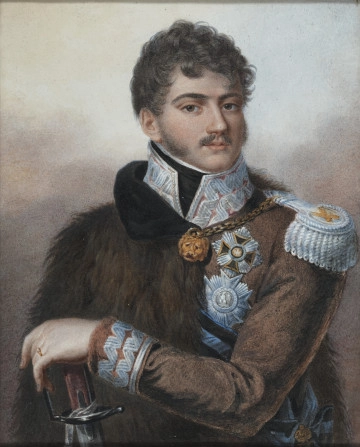
Doctor Śliwiński in a carriage
19th (?) century
Castle Museum in Łańcut
Part of the collection: Malarstwo i rysunek
Interior of the Baths of Caracalla in Rome A painting from the collection of the Lubomirski family, former owners of the caste, behind glass, in white passe-partout, presenting the interior of the Baths of Caracalla in Rome. The light is falling from the left side of the painting, its source is the sun, not shown in the painting. A view from the vaulted interior of the tepidarium through the entrance arcade to the frigidarium ruins. The ruins are overgrown with vine in bright green colours, muted with grey and in places where the sun rays are falling ˗ golden. The composition is closed; it is only through the frigidarium arcades (in the back in the centre of the painting) where it opens to the distant, hazy and hilly landscape with buildings. Inside, there are groups of people collecting hay and hunting snakes. At the bottom, there is a caption on the passe-partout: “Vue de l intérieur des Thermes de Caracalla a Rome” and “Volpato et du Cros.” The Baths of Caracalla are the best preserved Roman baths, they are located to the south-west of Via Appia. Their construction started around 206 during the reign of Septimus Severus and they were commissioned in 216-217 during the reign of Caracalla, thence their name. The entire complex occupied approx. 12 hectares; there were cloakrooms, a palaestra (for gymnastic exercises), rooms for massage and leisure, a library, as well as saunas and a swimming pool with hot water. The interior of the building was decorated with numerous niches and recesses. The walls and the floors were covered with paintings and mosaics. The tepidarium is a leisure room with a heated floor ˗ the heat radiated from the walls and the floor. The frigidarium is a pool with cold water; one cooled there after bathing in the pool with hot water. Giovanni Volpato, one of the authors of the picture, was an engraver (born in Bassano del Grappa, died in Rome). In 1792, together with Louis Ducros, he published a series of prints of the interior of the new Museo Pio Clementino. Abraham Louise Rodolphe Ducros (born in 1748 in Yverdorn in Switzerland, deceased in 1810) was a self-taught painter. He painted primarily watercolours. In 1776, he left for Rome and spent 30 years there. When in Italy, he saw the graphic prints of Piranesi and the works of this artist greatly affected him. The artwork is framed in frames identical to the pictures presenting pavilions and gazebos in the Chinese style and displayed in the Pompeii room of the Chinese Apartment on the first floor of the castle.
Author / creator
Dimensions
height: 86.5 cm, width: 64 cm
Object type
Painting and drawing
Technique
aquarel
Material
wood, paper
Origin / acquisition method
decyzja administracyjna
Creation time / dating
Creation / finding place
Owner
Castle Museum in Łańcut
Identification number
Location / status

Kossak, Juliusz
19th (?) century
Castle Museum in Łańcut

Masłowski, Stanisław
19th (?) century
Castle Museum in Łańcut

Benner, Henryk
1st quarter of the 19th century
Castle Museum in Łańcut
DISCOVER this TOPIC
Castle Museum in Łańcut
DISCOVER this PATH
Educational path
0/500

We use cookies to make it easier for you to use our website and for statistical purposes. You can manage cookies by changing the settings of your web browser. More information in the Privacy Policy.
We use cookies to make it easier for you to use our website and for statistical purposes. You can manage cookies by changing the settings of your web browser. More information in the Privacy Policy.
Manage cookies:
This type of cookies is necessary for the website to function. You can change your browser settings to block them, but then the website will not work properly.
WYMAGANE
They are used to measure user engagement and generate statistics about the website to better understand how it is used. If you block this type of cookies, we will not be able to collect information about the use of the website and we will not be able to monitor its performance.